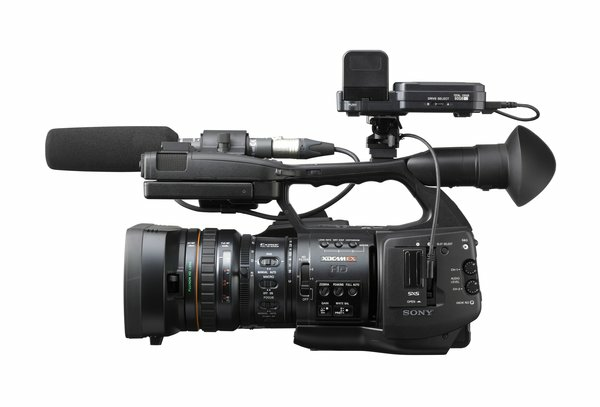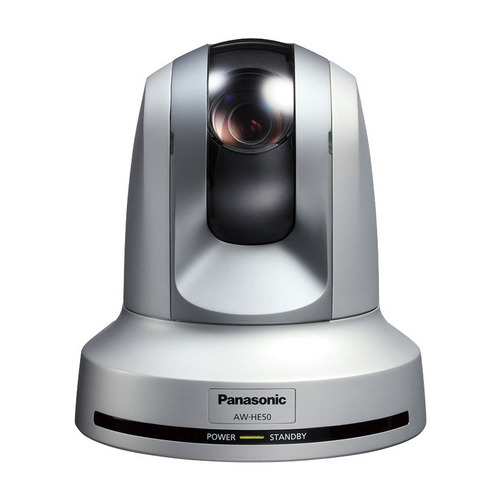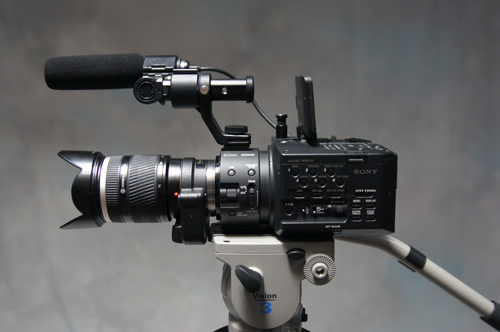HD Webcast Video Production: Choosing a Video Camera
This article will be the first in a series of articles on webcasting and will cover a wide range of topics including video cameras, video switchers, converters, computer inputs, audio, reference monitors, webcast hardware, webcast software, live streaming services providers, and some additional hardware that is important in order to produce a professional live webcast.
Camcorder Video Cameras

The Sony PMW EX1-R
Camcorders are generally smaller video cameras that can be handheld or tripod mounted but not shoulder mounted without a shoulder-mount rig. They typically have smaller 1/4" , 1/3", or 1/2" sensors and come with a fixed video lens that requires lens adapters if you require wider or more telephoto then the lens allows. Camcorders have servo lenses so you can zoom with a zoom rocker or on the lens barrel.
Smaller sensors and fixed lenses mean lower cost, and a professional camcorder typically costs between $4,000-8,000.
PTZ CCTV or POV Cameras

Panasonic AW-HE50SN HD Integrated PTZ Camera
Pan-Tilt-Zoom (PTZ) Closed Circuit TV and Point of View (POV) video cameras are generally less expensive compared to camcorders and ENG video cameras but they lack manual controls and can have very small sensors. These cameras are generally used without an operator, although PTZ cameras can be operated remotely.
Prices for POV and PTZ cameras range from $300 for the popular GoPro Hero2 to more than $5,000 for high-end PTZ models.
Large Sensor Video Cameras

Sony NEX-FS100 video camera
When videographers started using DSLR cameras like the Canon 5DMKII to record video, a whole new trend of large-sensor video acquisition was started. The benefits of a single large-sensor video acquisition in cinematography circles is that a large sensor allows for an image with a shallow depth of field and a pleasing defocused background blur, known as bokeh. Webcasters appreciate the shallow depth of field as well as it brings focus away from a potentially bland or distracting background and onto the subject. This background blur also is very web codec-friendly; a defocused background has less bit-rate hogging detail so more bits can be allocated to the important in-focus areas of the image.
Video producers know that in live video production environments they have less control of pretty much everything, and there are no additional takes, so there are limits to how shallow a depth of field you want. An f/2.8 at the end of a 70-200mm zoom lens is too shallow when filming a speaker at a podium as the subject will go out of focus with every to-and-fro motion, but f/4.0-5.6 is more forgiving and still results in a defocused background.
Large-sensor video cameras accept a wide range of photographic lenses but they do not have any electronic servo controls, so zoom, focus, and iris are generally operated manually. Some large-sensor cameras have smart lens adapters that add back some electronic or auto functionality, but servo lens support is not yet available.
Prices for large-sensor video cameras range from $5,000 to $16,000 although lenses range from $25 thrift-store finds to $2,500 professional SLR lenses, to tens of thousands of dollars for cinema lenses.
Codecs
Intraframe SD video codecs weren't too affected by video noise, but HD long-GOP codecs like HDV struggle to average the noise pattern over their 15-frame group of pictures that long-GOP codecs use. Internal video codecs are less a concern for a live webcast as the live video output from a video camera is an uncompressed video signal before the codec compresses the image. You need to consider the internal codec and recording media only if preserving each camera's video for later editing or as a backup.
Media cost, recording length, ease of ingest, and ease of editing are also important secondary considerations. Tape-based video cameras are being phased-out but, again, the signal that comes out of the video camera is higher quality than the recorded compressed video signal, so an older HD video camera with the right video outputs can still be useful. The biggest codec consideration for webcasting is not the camera's codec but the webcasting codec. I'll cover this more in a future article in this series, but webcasting codecs are long-GOP codecs, so having less background detail and noise allow you to preserve more detail within the limited webcast bit-rate.
Related Articles
In this ongoing Streaming Media Producer series on webcast video production, Shawn Lam covers the video format converters he uses in his own HD webcast workflows, and one new converter that just might be the video converter, scaler, and distribution amplifier to rule them all.
Now featuring a new interview from NAB 2013 on the Sound Devices Pix240i, this article looks at a handful of portable and rackmount external video recorders for live HD production, specifically in the role of recording the master program feed from a live switch.
This article is the fourth in a series on webcast video production and discusses video switchers, including the cost and features that differentiate several popular models.
The Sony NEX-FS700 has much to recommend it as a top-flight large-sensor, interchangeable-lens camcorder and as a worth-the-upgrade successor to the Sony FS100. And it's 4k support and 10x slo-mo are nothing to sneeze at. But what makes it the best camera in the market for webcast producers?
Part 2 of this series on webcast video production focuses on Sony's NEX-FS100 large-sensor camcorder and new capabilities added via a firmware upgrade that (among other things) makes it compatible with Sony's LA-EA2 lens adapter. While it's not as strong a webcast camera as the FS700 (review coming soon), it still has much to recommend it.